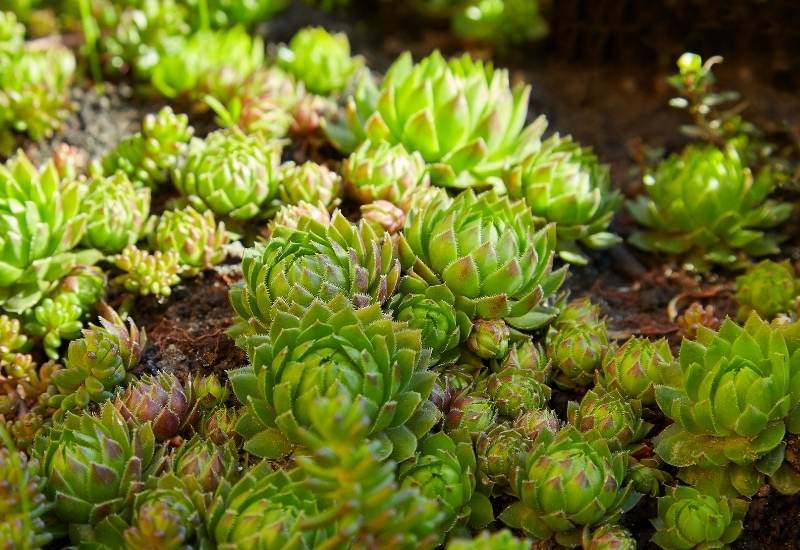
Use succulent plants as ground cover; you won’t need to worry about unsightly bare soil in your garden! Just imagine colorful rosettes, leaves that look like works of art, and even flowers as bright as the Sun can fill even large areas of your garden… all year round, and with very little work for you!
Low-growing with a creeping, spreading habit, ground covering succulents like Hens and chicks or stonecrop are an attractive and simple lawn grass alternative to fill the bare ground, suppress weeds, and prevent erosion while requiring minimal maintenance and less water use.
There are plenty of great options to add color and texture to the typical evergreen landscape. Some varieties will thrive in poor soil and drought, while cold-hardy varieties are suitable for northern winters.
You may feel a bit lost with the variety of colors, shapes, and growing conditions you find with succulents that spread. But don’t worry; the suggested groundcover succulents and tips for growing them will help you to choose the perfect outdoor succulents to add to your landscape.
These beauties will wow you soon, but first, let me tell you why some succulents are great as ground cover and why you should choose them.
Why Succulents Make Good Ground Cover?
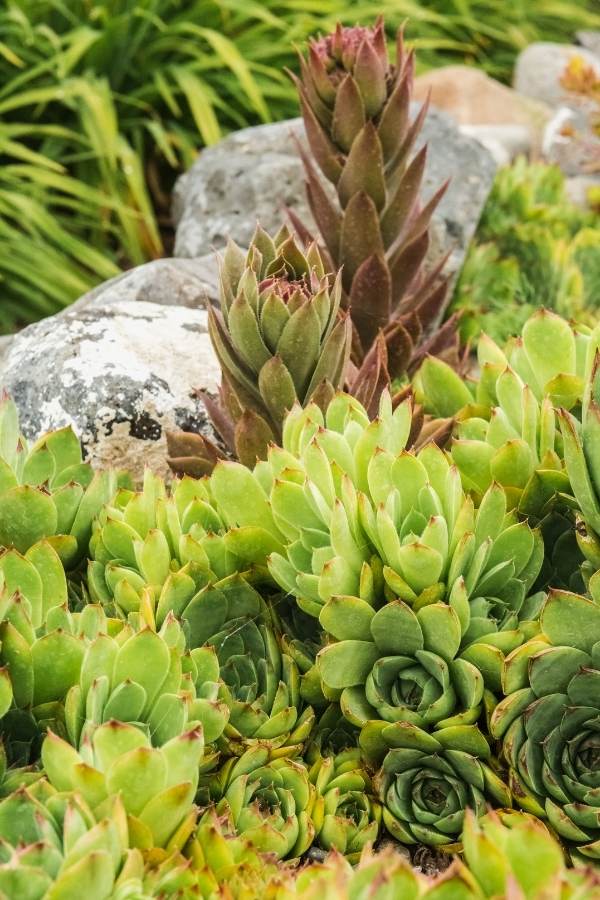
Not all succulents are good as ground cover, of course! You can’t use a Saguaro cactus, or a Joshua tree, for example. But… think about hens and chicks, purslane, echeveria, stonecrop chalk sticks etc.… These low growing succulents plants have the qualities you need for ground cover:
Fine, but there is far more. Remember? I didn’t say they are “fine” as ground cover… I said they are “perfect”. Do you want to see why?
Why Do Succulents Make Excellent Ground Cover Plants?
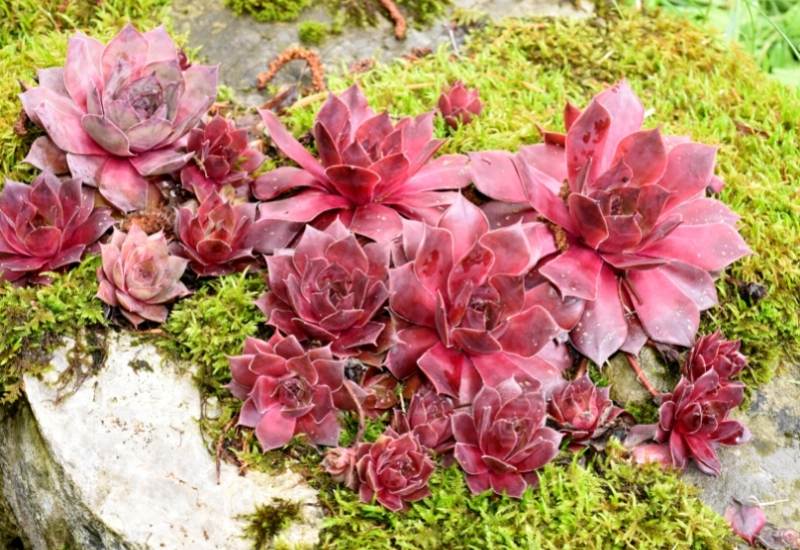
Succulents always seem to have that extra gear when you compare them with other plants. And even when it comes to how low growing succulents work as ground cover… You guessed! Succulents have extraordinary qualities.
Here are the 7 reasons to use succulents as groundcover:
You see, I was right: some succulents are excellent as ground cover. And I will tell you more: they need very little care, but a few tips for all of them will come in handy; so here they are…
Tips for Growing Succulents As Groundcover
There are growing needs that change for each succulent, like the hardiness, etc. But on the whole, succulents have very similar needs.
There are exceptions, like bromeliads, but almost all the plants in our shortlist have a core set of care instructions.
There is one little exception, the species of Tradescantia we will see can manage a bit more watering than the other plants.
It’s a strange succulent. It can do with dry conditions but will not die like other succulents if you water more abundantly. This is on the condition that it has very well-drained soil.
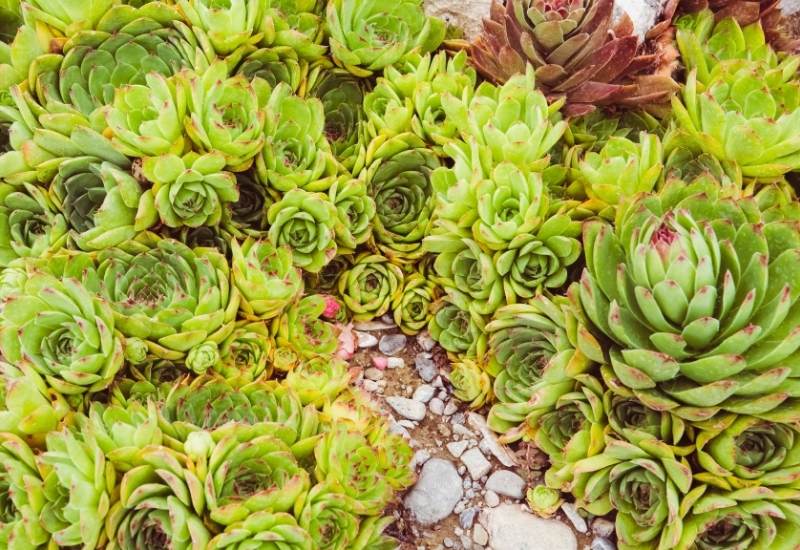
Follow these outdoor succulent gardening tips to help you keep your babies alive and thriving
15 Succulents That Are Great Ground Covers
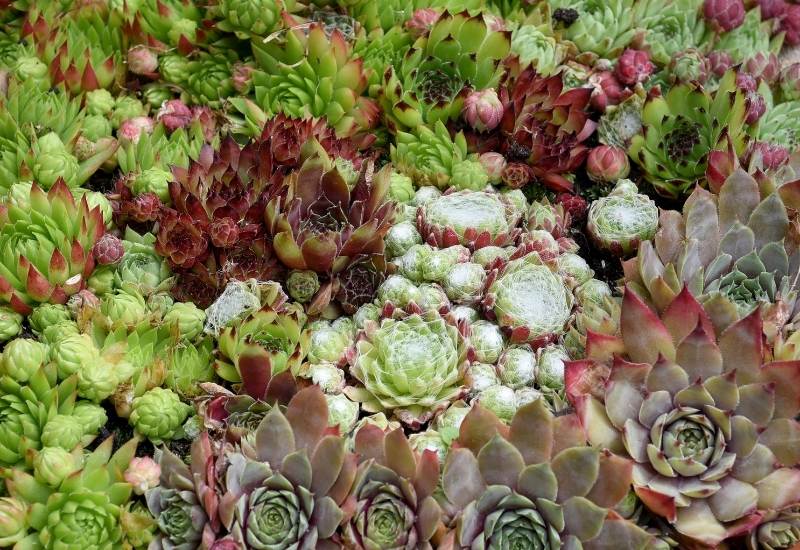
That’s it! Basically, with succulent ground cover plants, “less is more.”
This will be quite convenient if you have little time for your gardening chores!
And now let me show you the very best succulents you can choose as ground cover…
These low-maintenance groundcover succulents add lushness and color to any barren ground in your landscape, even in dry conditions.
1: Hens and Chicks (Sempervivum spp)
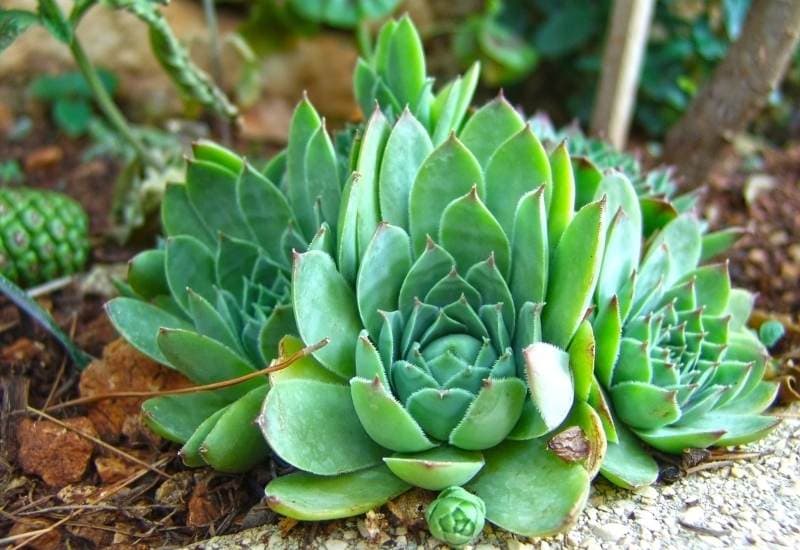
Hens and chicks is one of the best succulents for ground cover, if not “the best” ever! We will see a select few soon, but the whole genus is perfect. Why? The rosettes of this plant are beautiful, they propagate naturally.
They are very low and there are green, red, purple, blue and variegated ones… Finally… as a genus, Sempervivum is one of the hardiest! Some will do very well even in cold USDA zone 3! This is because they are “mountain succulents”…
Grow hens and chicks as a hassle free ground cover choice. They are very strong and healthy, they require little care and you have a great choice of varieties.
2: Hens and Chicks ‘Red Rubin’ (Sempervivum ‘Red Rubin’)
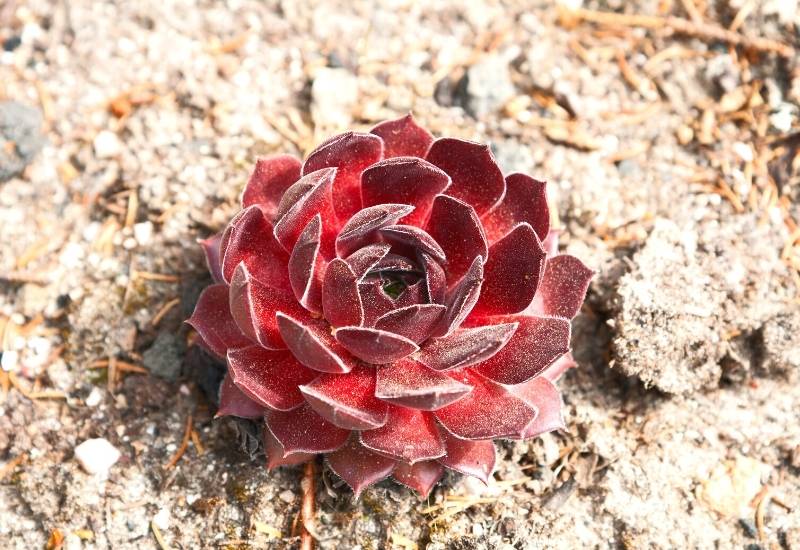
Hens and chicks ‘Red Rubin’ is excellent if you want to cover the earth with the most vibrant and flaming color! No need to say that it is perfectly ruby red in shade.
It forms beautiful and full rosettes of fleshy pointed petals. These are arranged fairly regularly and they have a light and white fuzz on them.
This is a fairly large and showy variety. It is excellent if you want a bit more than just “cover bare soil”. The fact is that it will certainly become a focal point.
In summer, this groundcover succulent also produces very showy pink and star shaped flowers. Finally, if the color fades, it’s because the light is low.
3: Stonecrop ‘Class Act’ (Sedum ‘Class Act’)
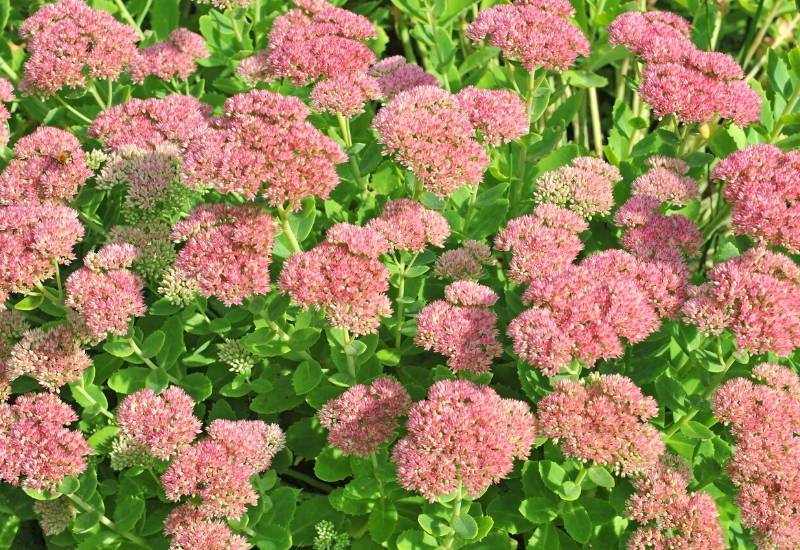
Stonecrop ‘Class Act’ has a classic look, with rounded green leaves that grow on stems. The color can take on some purple hues late in the season though, and in some cases, it will have some blue shades in it.
But this spreading succulent plant really wows with its long and bright blooms of burgundy red flowers. They are abundant, on large inflorescences that come on upright pink stems.
‘Class Act’ is a winner of the Award of Garden Merit by the Royal Horticultural Society. If you want tradition and beauty, this sedum variety is a perfect choice.
4: Purple Heart (Tradescantia pallida ‘Purpurea’)
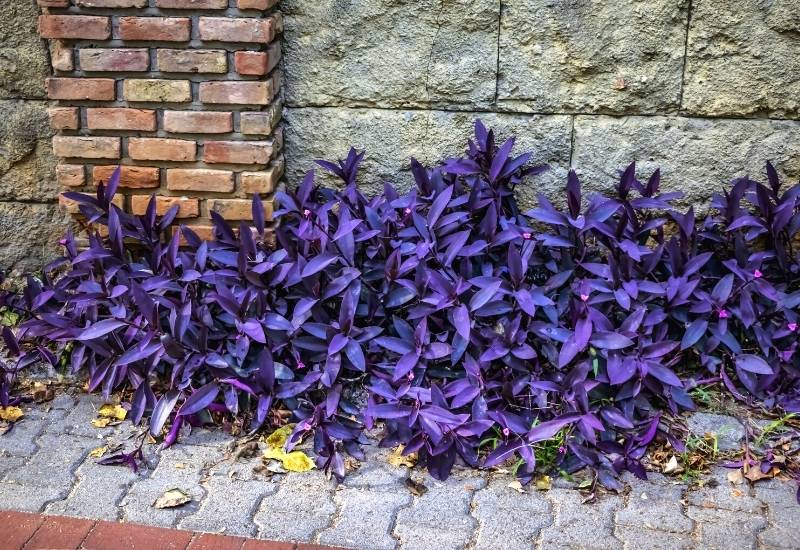
Purple heart is a common ground cover succulent thanks to its beautiful leaves. They are elliptical and slightly pointed, with purple overrides and violet undersides.
Let me tell you a secret… Look at them from underneath and they are actually translucent! No wonder it has won the Award of Garden Merit by the Royal Horticultural Society.
They grow easily and abundantly but they do break easily too. This is a trailing beauty which will also give you lovely flowers from late spring. These are pink and unusually have three leaves.
This is typical of the Tradescantia genus. As a final note, this is a strange genus with some succulents and some herbaceous plants, but all good as ground cover.
5: Blue Chalk Sticks (Senecio serpens)
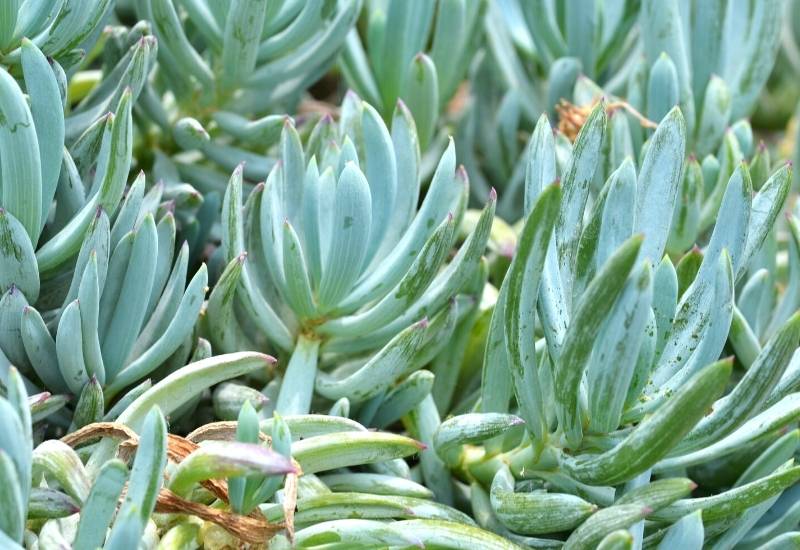
Just imagine a sea of upright, low-growing succulents with blue leaves that look like chalk sticks. They actually do! And they are covered in a white patina that adds some “icing” adding to the chalk effect,
Senecio serpens is a great flowering succulent ground cover plant that can create a lunar or under sea landscape, and it also blooms with creamy white flowers in summer.
It is excellent for artistic gardens, including modern and urban gardens. Your visitors will be wowed by the ice blue color of this plant and its original look of this amazing carpeting succulent.
6: Broadleaf Stonecrop (Sedum spathulifolium ‘Purpureum’)
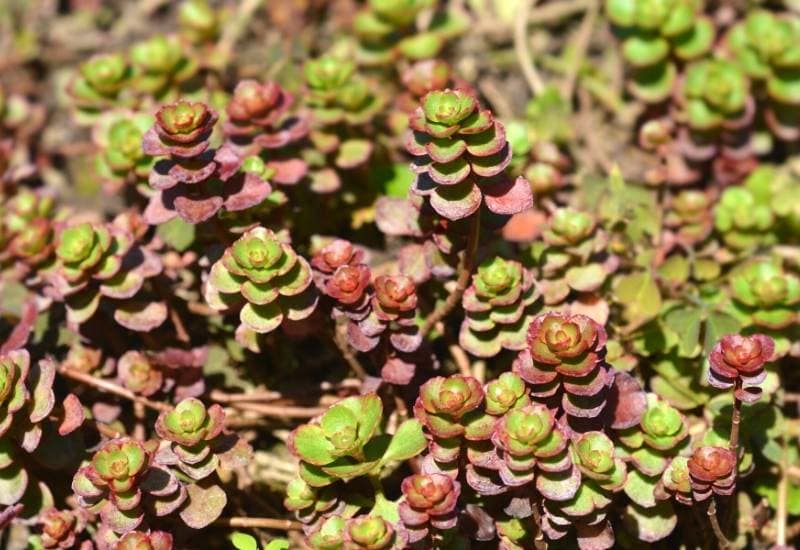
Broadleaf stonecrop will cover soil and rocks alike with wonderful round leaves, arranged in small rosettes. And wait! They are silver blue with purple pink edges! The effect is striking and delicate at the same time.
The small size of the leaves gives it a fine and texture while the color gives this plant a “fairy tale” quality to this succulent beauty. No wonder it has won the Award of Garden Merit by the Royal Horticultural Society!
Broadleaf stonescrop is ideal for small places in full view. If you have a raised spot that needs covering it will bring the sweet beauty of this plant closer to eye level.
7: ‘Lipstick’ Echeveria (Echeveria agavoides ‘Lipstick’)
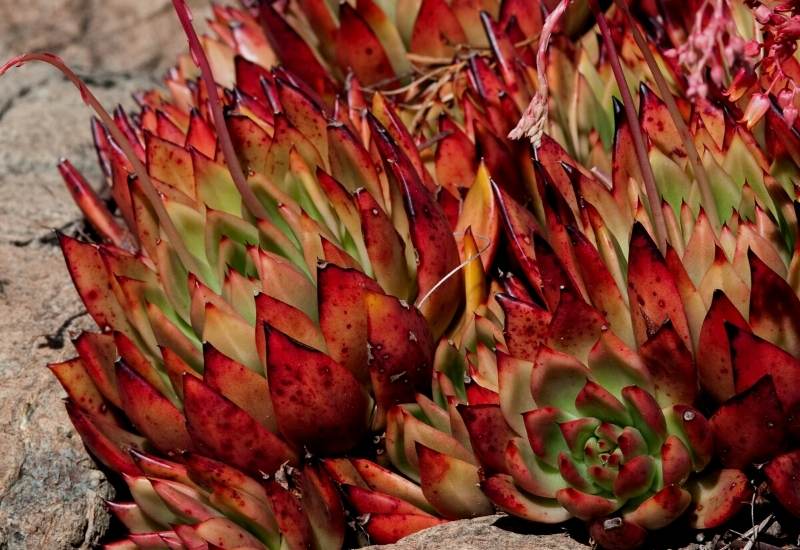
Few echeveria varieties are suitable as carpeting plants, but the super colorful ‘Lipstick’ echeveria is. This is because it spreads with pups and stolons, forming large clumps you can use as ground cover.
The rosettes are the most colorful ever! They leaves are bright green at the base and of the most vibrant crimson red tips and margins.
You can use ‘Lipstick’ echeveria to cover small patches of land and turn them into a color display like few other plants can. It is suitable for informal but also formal gardens, given its showy appearance.
8: Stonecrop ‘ Cherry Truffle’ (Sedum telephium ‘Cherry Truffle’)
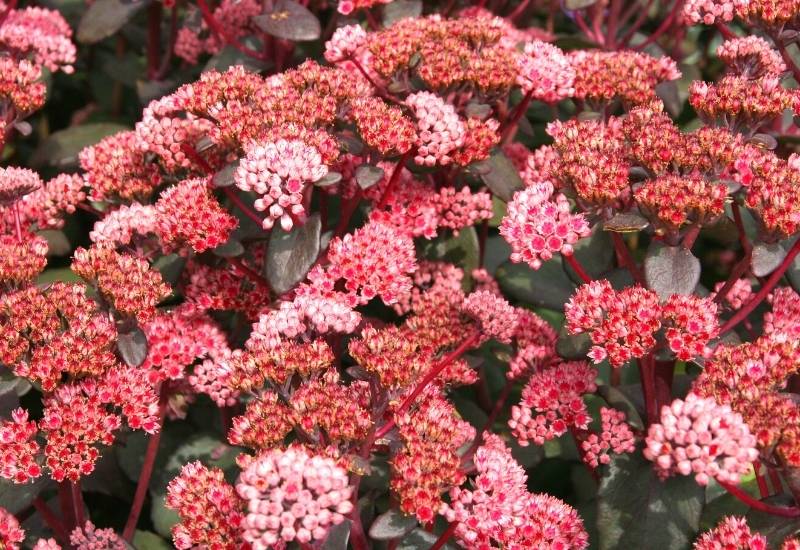
Stonecrop ‘Cherry Truffle’ is a very expressive and emotional plant to use as ground cover. This is due to its intense coloring, which is quite unique. It is of a dark cherry purple shade with gray green parts that turn copper orange late in the season.
The leaves are disposed in rosette shapes along the stems. And in summer, beautiful cymes of rich pink flowers top the foliage.
‘Cherry Truffle’ is perfect for romantic and passionate gardens. It is a plant that will cover the soil with strong, passionate emotions – not just leaves and flowers!
9: Moss Rose (Portulaca grandiflora)
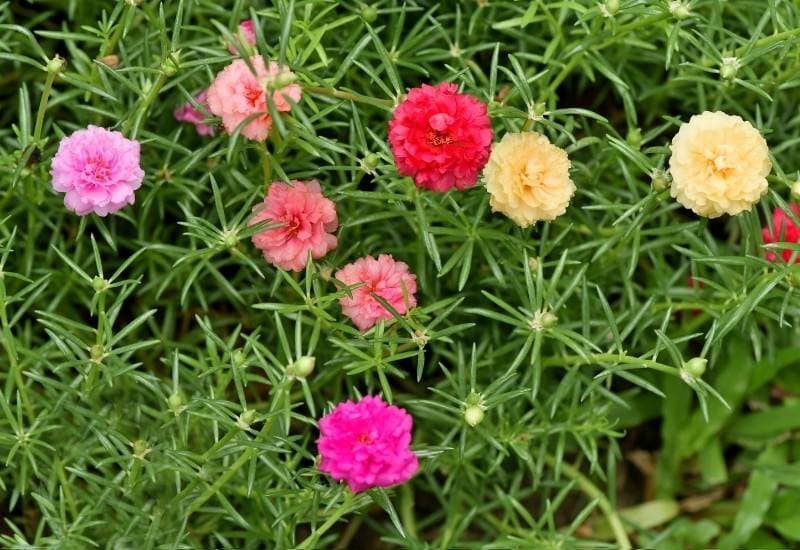
Moss rose is one of the most vibrant and colorful flowering succulents you choose as choose cover. Unlike other succulents, its main attraction are the showy daisy like flowers.
These can be yellow, orange, magenta, red or even white, and they are always brightly colored. And they blossom from spring all the way to the first frost or the end of fall! And it is very, very cold hardy too!
This is a lovely, playful, bright and sweet looking succulent, mainly adaptable to informal gardens. You can use it for medium sized areas, where it will bloom non stop for months asking only for very basic maintenance.
10: Hens and Chicks ‘Pacific Blue Ice’ (Sempervivum ‘Pacific Blue Ice’)
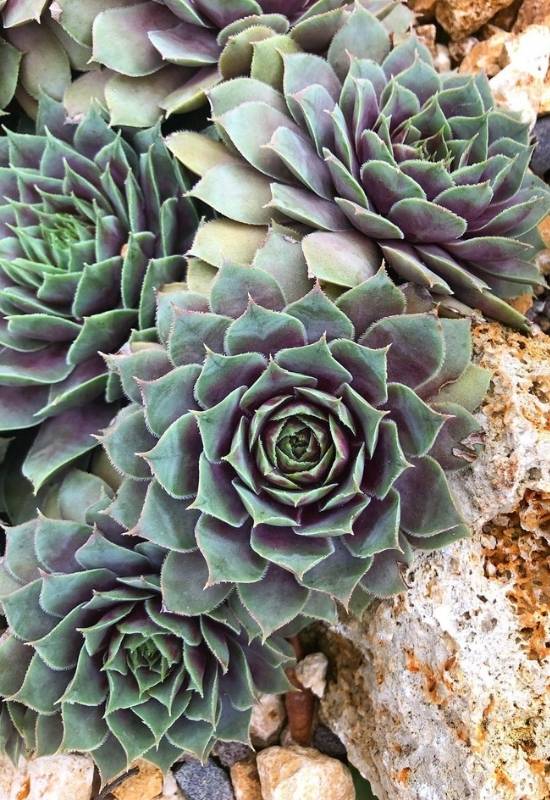
Grow hens and chicks ‘Pacific Blue Ice’ and it will look like an artist has covered your land with little stone roses… Why? The rosettes of this Sempervivum have long and pointed leaves (like those of houseleek), so they are clearly shaped. The color though makes it look like some precious stone. It is on the light purple pink shade on a blue undertone.
It is a good choice for an elegant part of your garden. This hens and chicks is also good in less prominent positions, as background. This is because the color is very delicate.
11: Jellybean Stonecrop (Sedum x rubrotinctum)
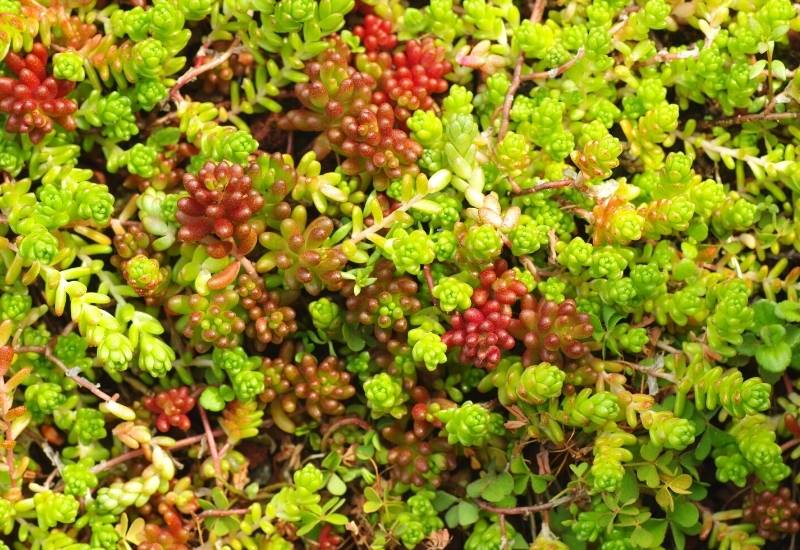
Jellybean stonecrop is a playful creeping succulent your children will fall in love with! It is a tiny plant with beautiful “long balloons” or jellybean shaped leaves.
They look like sweets, also because they are smooth in texture. And the color? They are variegated, green and orange red, and, if the light is right, even crimson red. So, the contrast is quite striking.
This is a lovely little carpeting plant for small areas. It just looks sweet and showy at the same time. As we said, it’s a great plant or kids, or for a childhood inspired garden.
12: Wandering Jew (Tradescantia zebrina)
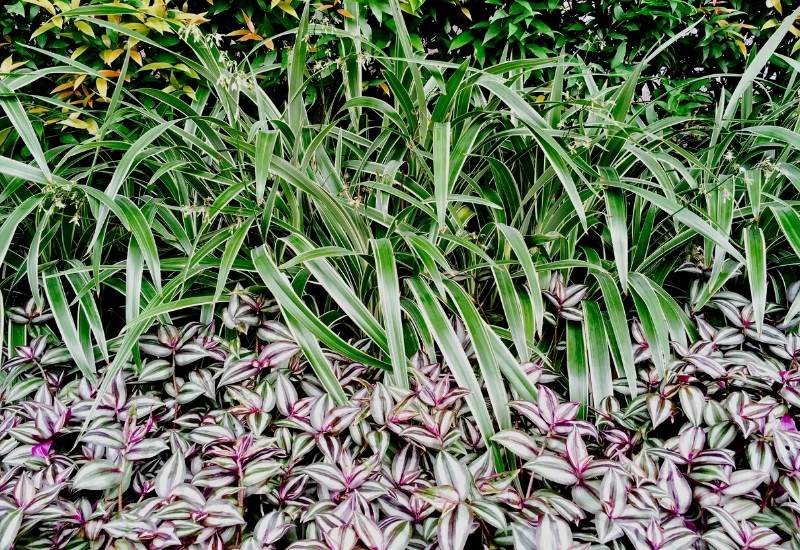
Wondering jew is a trailing succulent with leaves that look like zebras. They have stripes lengthways that can vary in color. These can be purple, cream or green. You will always have purple stripes, the green or cream depend mainly on the light.
It creates wonderful patterns on the ground, turning bare soil into an elegant tapestry. No wonder it is a receiver of the Award of Garden Merit by the Royal Horticultural Society.
It’s a beautiful plant that can break easily but they will grow back fast. It is excellent for most types of gardens, including formal ones.
13: Soap Aloe (Aloe maculata)
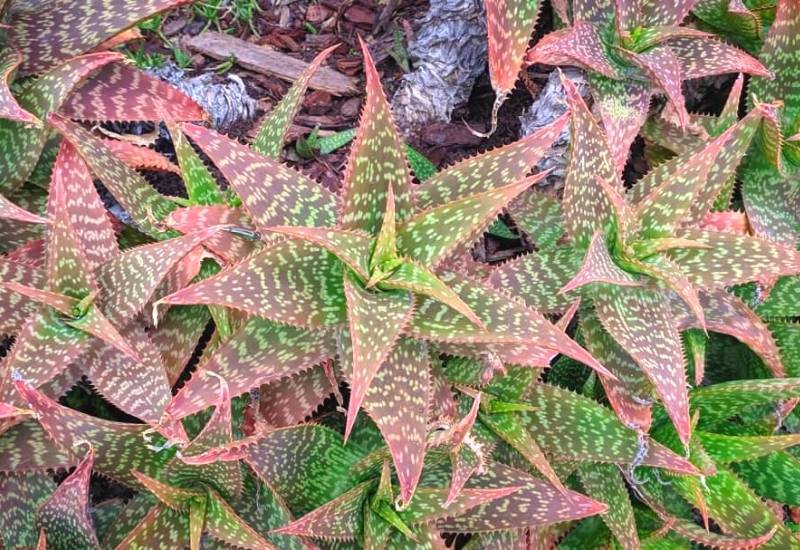
Soap aloe has the amazing rosettes typical of aloe plant, and it does spread horizontally over the ground. But it also has spotted leaves… They are if a dark green color with almost white, very regular spots on them.
The teeth too are decorative, of a gold shade. But wait till it blossoms in late winter and on top of the rosettes you will get a flash of fiery red flowers that will last well into the spring!
It is good for larger areas, as this is a fairly large plant. It is also ideal for a spot where all your guests can see it; it is far too decorative and showy to relegate to the back of your garden!
14: Peacock Echeveria (Echeveria peacockii)
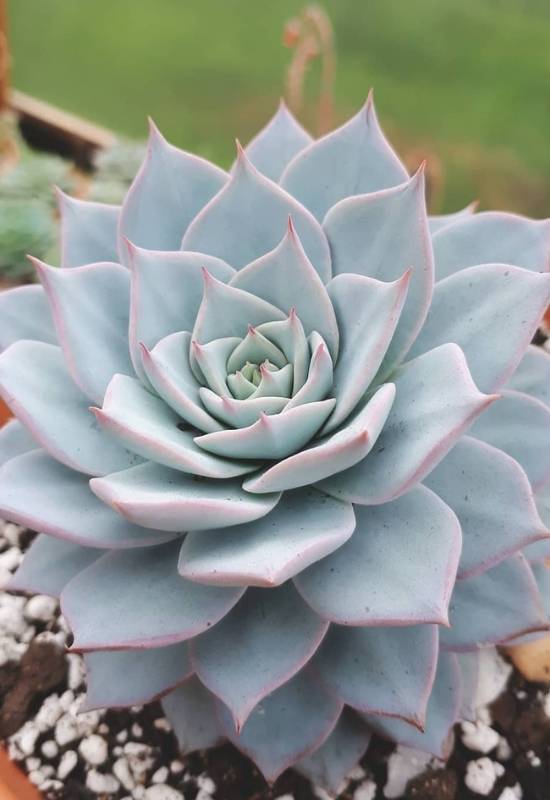
This spreading succulent is aptly called peacock echeveria, because it is so colorful and showy! In fact it is hard to say which color the rosettes are: orange, yellow, yellow, blue, red, green, purple..
You will get a combination of all these in different quantities according to the individual or the light and the season… It’s just a striking plant!
Grow it somewhere where the light hits it well. You won’t believe the color effects this ground cover plant can have.
It is even translucent against the light! It will be like having an always changing work of art in your garden. Or a strange collection of colorful jewels on the ground!
15: Hottentot Fig (Carpobrotus edulis)
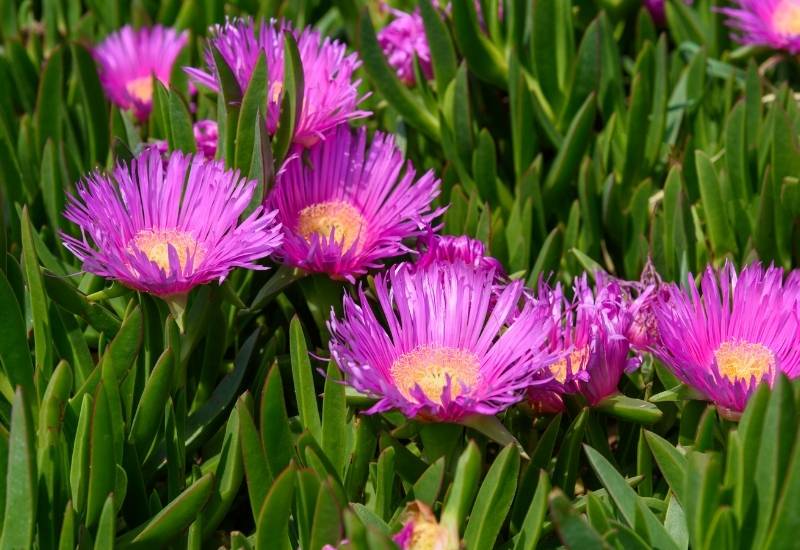
This South African creeper, known as Hottentot fig or ice plant, is a real wonder to behold! It will form large trailing clumps of stick shaped leaves, that point up and look like french fries…
But then the flowers come in late spring and they are just… massive, colorful, amazing! They have many petals, like daisies, usually magenta, but often yellow, orange or sometimes white . each flower can be up to 6 inches wide (15 cm).
Hottentot fig ice plant is a big and fast growing ground-creeping plant with succulent leaves. So, it is ideal for large spaces. It grows well in the sand too. In fact in South Africa or the Mediterranean where it grows spontaneous, it often covers whole cliffs, or large beaches by the sea… And it’s a spectacle!
Succulents: Excellent and Amazing Ground Cover Plants!
I hope I have convinced you that you don’t need to grow your succulents only in pots! Some are excellent ground cover; they just have it all!
They are evergreens, they have amazing foliage shapes and colors, great flowers… They are so low maintenance that most people literally forget about them…
And if you are worried about cold climate, some can even grow in freezing USDA zone 2!
Just look at the pictures… Come on, I know you want to grow them in your garden now…

Written By
Adriano Bulla
After many years as an academic in London, Adriano Bulla became a writer, publishing books like A History of Gardening, Organic Gardening and Elements of Garden Design; he then decided to become a gardener, following his childhood dream, and has been following his dream writing and gardening professionally in Southern Europe, where he has specialized in new and innovative organic gardening fields and techniques, like permaculture, regenerative agriculture, food forests and hydroponics.

WHERE DO YOU GET SUCCULENTS PLANTS , THEY LOOK GREAT, GEORGE